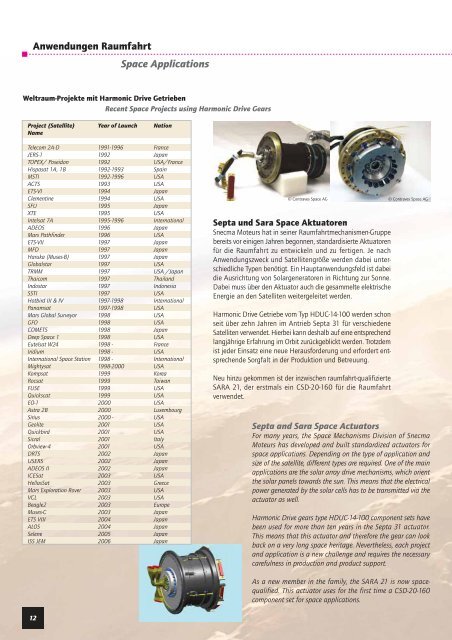Harmonic Drive AG - Harmonicdrive.aero
Harmonic Drive AG - Harmonicdrive.aero
Harmonic Drive AG - Harmonicdrive.aero
Erfolgreiche ePaper selbst erstellen
Machen Sie aus Ihren PDF Publikationen ein blätterbares Flipbook mit unserer einzigartigen Google optimierten e-Paper Software.
Weltraum-Projekte mit <strong>Harmonic</strong> <strong>Drive</strong> Getrieben<br />
Recent Space Projects using <strong>Harmonic</strong> <strong>Drive</strong> Gears<br />
Project (Satellite) Year of Launch Nation<br />
Name<br />
Telecom 2A-D 1991-1996 France<br />
JERS-1 1992 Japan<br />
TOPEX/ Poseidon 1992 USA/France<br />
Hispasat 1A, 1B 1992-1993 Spain<br />
MSTI 1992-1996 USA<br />
ACTS 1993 USA<br />
ETS-VI 1994 Japan<br />
Clementine 1994 USA<br />
SFU 1995 Japan<br />
XTE 1995 USA<br />
Intelsat 7A 1995-1996 International<br />
ADEOS 1996 Japan<br />
Mars Pathfinder 1996 USA<br />
ETS-VII 1997 Japan<br />
MFD 1997 Japan<br />
Haruka (Muses-B) 1997 Japan<br />
Globalstar 1997 USA<br />
TRMM 1997 USA /Japan<br />
Thaicom 1997 Thailand<br />
Indostar 1997 Indonesia<br />
SSTI 1997 USA<br />
Hotbird III & IV 1997-1998 International<br />
Panamsat 1997-1998 USA<br />
Mars Global Surveyor 1998 USA<br />
GFO 1998 USA<br />
COMETS 1998 Japan<br />
Deep Space 1 1998 USA<br />
Eutelsat W24 1998 - France<br />
Iridium 1998 - USA<br />
International Space Station 1998 - International<br />
Mightysat 1998-2000 USA<br />
Kompsat 1999 Korea<br />
Rocsat 1999 Taiwan<br />
FUSE 1999 USA<br />
Quickscat 1999 USA<br />
EO-1 2000 USA<br />
Astra 2B 2000 Luxembourg<br />
Sirius 2000 - USA<br />
Geolite 2001 USA<br />
Quickbird 2001 USA<br />
Sicral 2001 Italy<br />
Orbview-4 2001 USA<br />
DRTS 2002 Japan<br />
USERS 2002 Japan<br />
ADEOS II 2002 Japan<br />
ICESat 2003 USA<br />
HellasSat 2003 Greece<br />
Mars Exploration Rover 2003 USA<br />
VCL 2003 USA<br />
Beagle2 2003 Europe<br />
Muses-C 2003 Japan<br />
ETS VIII 2004 Japan<br />
ALOS 2004 Japan<br />
Selene 2005 Japan<br />
ISS JEM 2006 Japan<br />
12<br />
Anwendungen Raumfahrt<br />
Space Applications<br />
© Contraves Space <strong>AG</strong> © Contraves Space <strong>AG</strong><br />
Septa und Sara Space Aktuatoren<br />
Snecma Moteurs hat in seiner Raumfahrtmechanismen-Gruppe<br />
bereits vor einigen Jahren begonnen, standardisierte Aktuatoren<br />
für die Raumfahrt zu entwickeln und zu fertigen. Je nach<br />
Anwendungszweck und Satellitengröße werden dabei unterschiedliche<br />
Typen benötigt. Ein Hauptanwendungsfeld ist dabei<br />
die Ausrichtung von Solargeneratoren in Richtung zur Sonne.<br />
Dabei muss über den Aktuator auch die gesammelte elektrische<br />
Energie an den Satelliten weitergeleitet werden.<br />
<strong>Harmonic</strong> <strong>Drive</strong> Getriebe vom Typ HDUC-14-100 werden schon<br />
seit über zehn Jahren im Antrieb Septa 31 für verschiedene<br />
Satelliten verwendet. Hierbei kann deshalb auf eine entsprechend<br />
langjährige Erfahrung im Orbit zurückgeblickt werden. Trotzdem<br />
ist jeder Einsatz eine neue Herausforderung und erfordert entsprechende<br />
Sorgfalt in der Produktion und Betreuung.<br />
Neu hinzu gekommen ist der inzwischen raumfahrt-qualifizierte<br />
SARA 21, der erstmals ein CSD-20-160 für die Raumfahrt<br />
verwendet.<br />
Septa and Sara Space Actuators<br />
For many years, the Space Mechanisms Division of Snecma<br />
Moteurs has developed and built standardized actuators for<br />
space applications. Depending on the type of application and<br />
size of the satellite, different types are required. One of the main<br />
applications are the solar array drive mechanisms, which orient<br />
the solar panels towards the sun. This means that the electrical<br />
power generated by the solar cells has to be transmitted via the<br />
actuator as well.<br />
<strong>Harmonic</strong> <strong>Drive</strong> gears type HDUC-14-100 component sets have<br />
been used for more than ten years in the Septa 31 actuator.<br />
This means that this actuator and therefore the gear can look<br />
back on a very long space heritage. Nevertheless, each project<br />
and application is a new challenge and requires the necessary<br />
carefulness in production and product support.<br />
As a new member in the family, the SARA 21 is now spacequalified.<br />
This actuator uses for the first time a CSD-20-160<br />
component set for space applications.


